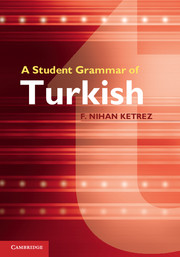Book contents
- Frontmatter
- Contents
- Acknowledgments
- Conventions used in the book
- Chapter 1 Introduction
- Chapter 2 The sounds of Turkish
- Chapter 3 The noun: an overview
- Chapter 4 Case markers
- Chapter 5 Genitive and possessive
- Chapter 6 Numerals and plurality
- Chapter 7 Existential var / yok
- Chapter 8 Pronouns
- Chapter 9 The verb: an overview
- Chapter 10 -Iyor, the progressive
- Chapter 11 Future with -(y)AcAK
- Chapter 12 Past with -DI and -(y)DI
- Chapter 13 -mIş and -(y)mIş
- Chapter 14 Present tense with the aorist -Ir/-Ar
- Chapter 15 -mAktA and -DIr
- Chapter 16 Imperative and optative
- Chapter 17 Compound tenses
- Chapter 18 Person markers
- Chapter 19 Postpositions
- Chapter 20 Passive
- Chapter 21 Causative
- Chapter 22 Reflexive
- Chapter 23 Reciprocal
- Chapter 24 Subordination
- Chapter 25 Infinitives with -mA and -mAK
- Chapter 26 Adjectives
- Chapter 27 Adverbials
- Chapter 28 Conditional
- Chapter 29 Ability and possibility with -(y)Abil
- Chapter 30 Obligation and necessity
- Chapter 31 Relative clauses
- Chapter 32 Word order
- Chapter 33 Questions
- Chapter 34 Negation
- Chapter 35 Coordination
- Chapter 36 Diminutive
- Chapter 37 Reduplication
- Chapter 38 Interjections and some idiomatic expressions
- Chapter 39 Spelling and punctuation
- Chapter 40 Conversation
- Appendix A Verbal inflection paradigms
- Appendix B Nominal inflection paradigms
- Appendix C Verbs categorized according to their case-marked complements
- Appendix D Verbs categorized according to their clausal complement types
- Appendix E Selected grammar books for further study
- Appendix F Answer key to the exercises
- Appendix G Glossary of grammatical terms
- Index
Chapter 3 - The noun: an overview
Published online by Cambridge University Press: 05 June 2012
- Frontmatter
- Contents
- Acknowledgments
- Conventions used in the book
- Chapter 1 Introduction
- Chapter 2 The sounds of Turkish
- Chapter 3 The noun: an overview
- Chapter 4 Case markers
- Chapter 5 Genitive and possessive
- Chapter 6 Numerals and plurality
- Chapter 7 Existential var / yok
- Chapter 8 Pronouns
- Chapter 9 The verb: an overview
- Chapter 10 -Iyor, the progressive
- Chapter 11 Future with -(y)AcAK
- Chapter 12 Past with -DI and -(y)DI
- Chapter 13 -mIş and -(y)mIş
- Chapter 14 Present tense with the aorist -Ir/-Ar
- Chapter 15 -mAktA and -DIr
- Chapter 16 Imperative and optative
- Chapter 17 Compound tenses
- Chapter 18 Person markers
- Chapter 19 Postpositions
- Chapter 20 Passive
- Chapter 21 Causative
- Chapter 22 Reflexive
- Chapter 23 Reciprocal
- Chapter 24 Subordination
- Chapter 25 Infinitives with -mA and -mAK
- Chapter 26 Adjectives
- Chapter 27 Adverbials
- Chapter 28 Conditional
- Chapter 29 Ability and possibility with -(y)Abil
- Chapter 30 Obligation and necessity
- Chapter 31 Relative clauses
- Chapter 32 Word order
- Chapter 33 Questions
- Chapter 34 Negation
- Chapter 35 Coordination
- Chapter 36 Diminutive
- Chapter 37 Reduplication
- Chapter 38 Interjections and some idiomatic expressions
- Chapter 39 Spelling and punctuation
- Chapter 40 Conversation
- Appendix A Verbal inflection paradigms
- Appendix B Nominal inflection paradigms
- Appendix C Verbs categorized according to their case-marked complements
- Appendix D Verbs categorized according to their clausal complement types
- Appendix E Selected grammar books for further study
- Appendix F Answer key to the exercises
- Appendix G Glossary of grammatical terms
- Index
Summary
Nouns and noun phrases
A noun is a word that refers to a person, a thing, a place, or a more abstract concept such as happiness. A noun phrase is a group of words that go along with a noun, such as adjectives, determiners, and other modifiers. In Turkish, just as it is the case in English, noun phrases appear in subject and object positions in a sentence. They also appear in the predicate position (e.g., ‘doctor’ in ‘he is a doctor’) and bear tense and person markers, just like verbs, in this position.
kadın (a noun) ‘woman’
sarışın kadın (noun phrase) ‘blonde woman’
şu dükkandaki kırmızı elbiseli sarışın kadın (noun phrase)
‘the blonde woman in the red dress at that shop’
As you see in the examples below, the noun in the noun phrase always appears at the end of the phrase and the others, the modifiers, precede it. A noun or a noun phrase appears in the following positions in a sentence:
As a subject:
Yaşlı kadın otobus bekliyordu.
Çocuklar parka gittiler.
Babam annemi aramış ama annem evde değilmiş.
As a direct object:
Annem gazeteyi okuyor.
Kim Türk kahvesi içti?
- Type
- Chapter
- Information
- A Student Grammar of Turkish , pp. 22 - 26Publisher: Cambridge University PressPrint publication year: 2012

